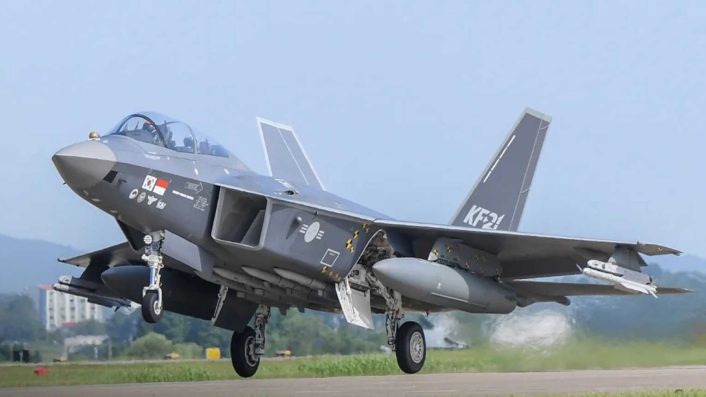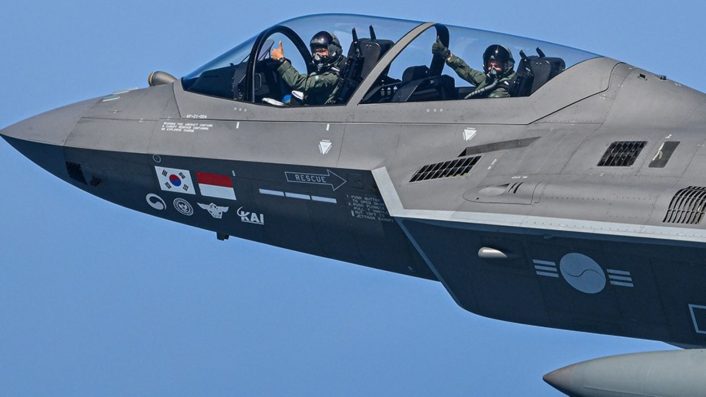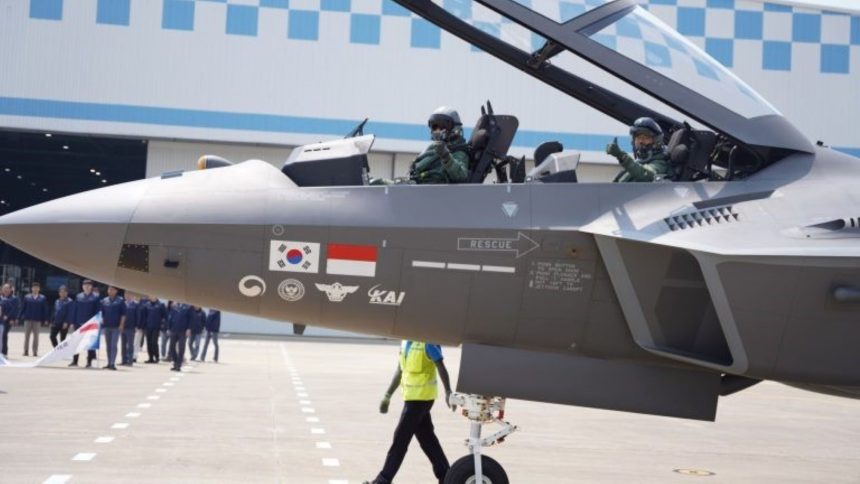Maj. Gen. Nowak flew in the KF-21’s backseat during a visit to KAI’s facilities, followed a day later by Col. Rigonald who became the first Indonesian pilot to test the jet.
The Polish Air Force’s chief, Maj. Gen. Iereneusz Nowak, and an Indonesian Air Force (TNI AU) test pilot, Col. Ferrel Rigonald, flew for the first time on the KF-21 Boramae on Jun. 26 and Jun. 27, 2025, respectively. The announcement comes shortly after Korea Aerospace Industries (KAI) revealed on May 20 that the first production model of the aircraft is in final assembly.
Nowak’s flight in the KF-21 was part of his visit to KAI headquarters in Sacheon, according to KAI, where the Polish Air Force’s FA-50PL jets are being manufactured. Nowak flew in the rear seat of the twin-seat variant of the aircraft, in what the company called a “test drive.”
🛩️🇰🇷🇮🇩 Indonesian Air Force (TNI AU) test pilot, Colonel Ferrel Rigonald @FRigonald61799, conducted the maiden flight of the KF-21 prototype from the front cockpit, accompanied by KAI pilot Koh Hwi Seok in the rear cockpit. pic.twitter.com/t4Iia2cAJQ
— OSINT Analyst (@RANOSINT) July 3, 2025
On the other hand, Rigonald piloted the aircraft from the front seat, Indonesia’s Ministry of Defense said, with KAI test pilot Koh Hwi Seok in the rear from the Sacheon air base. In fact, Indonesia is a primary joint development partner for the jet, which Jakarta has designated as the IF-X, and its pilots are expected to participate in the test campaign, with Rigonald being the first.
Still, Gen. Nowak seems excited before takeoff 😎🛫#PolishAirForce #KAI #KF21Boramae #TestFlight pic.twitter.com/CRpTY4stCT
— Hwarang (@KDefenseInsight) July 4, 2025
Indonesian Air Force pilot flies KF-21 for the first time
Calling it a “historic milestone,” the Indonesian MoD said Colonel Ferrel Rigonald and Koh Hwi Seok took off at 09:45 local time and successfully conducted a “series of test maneuvers at an altitude of 20,000 feet for approximately one hour.” This marked “Indonesia’s direct contribution to the testing and development process of the 4.5 generation fighter aircraft.”
“The participation of Indonesian Air Force pilots in the flight test phase not only reflects the transfer of technology and the improvement of the competence of Indonesian defense human resources, but also serves as a strong symbol of the spirit of strategic partnership between Indonesia and South Korea in the KF-21/IF-X fighter jet development program,” the statement added.
The TNI-AU pilot controlling the aircraft for the first time suggests both South Korea and Indonesia are putting behind the major financial and industrial disputes that have afflicted the project in the past.
View this post on Instagram
KF-21 Boramae
The KF-21 Boramae is part of South Korea’s efforts to build its own Gen 4.5 multirole fighter and to replace the older F-4 Phantom II and F-5 Tiger II jets. The new aircraft entered mass production in Jul. 2024.
According to reports, the Republic of Korea Air Force (ROKAF) plans to acquire a total of 120 KF-21s by 2032. South Korea’s Defense Acquisition Program Administration (DAPA) mentioned that the first production KF-21 is scheduled to be delivered to the Republic of Korea Air Force (ROKAF) in 2026, after completing acceptance test flights.
The aircraft is the first of 20 KF-21s included in the 1.96 trillion-won (US$1.41 billion) deal signed in June 2024 by KAI and DAPA. This was followed by a Jun. 27, 2025, contract between KAI and DAPA for 20 additional KF-21 jets.
Currently there are six prototypes, including two twin-seat variants, supporting the testing campaign. The KF-21 flew for the first time from KAI’s Sacheon facility on Jul. 19, 2022.

In its statement about Maj. Gen. Nowak’s first flight in the KF-21, KAI called the KF-21 a 4.5 generation fighter “that will evolve into a 6th generation fighter jet with manned and unmanned capabilities in the future.” The jet is expected to become the main fighter jet of the ROKAF along with the F-35.
The aircraft will also be equipped with European weaponry, such as the Meteor BVRAAM (Beyond Visual Range Air-to-Air Missile), IRIS-T short-range AAM, and, in future, the Taurus KEPD 350 air-launched cruise missile. It is also slated to be armed with a homegrown air-launched air-to-surface missile that was trialled in a separation test from a FA-50 late in Jun. 2025.
KF-21 and Indonesia
Col. Ferrel Rigonald piloting the KF-21 Boramae is part of Seoul’s and Jakarta’s 7.5 trillion Won ($6.3 billion) collaboration established in 2014, with the latter committed to paying 20% of the development cost. However, in 2018 Indonesia sought to renegotiate its share of the cost, resuming the payment of its share in 2022.
Problems surfaced in 2024, when two Indonesian engineers were accused of attempting to smuggle out the aircraft’s technical data in flash drives. The DAPA, the National Intelligence Service and the Defense Counterintelligence Command launched a probe, with the Herald Corporation subsequently reporting that it was found that no classified data leaks took place.
🇰🇷 South Korean KF-21 Boramae has flown for the first time today pic.twitter.com/ZhDVBuz4a0
— Fighterman_FFRC (@Fighterman_FFRC) July 19, 2022
The publication also reported that the Indonesian side had issues with the scope of the technology transfer. KEDGlobal reported on Jun. 13, 2025, that DAPA agreed to reduce Indonesia’s contribution for the KF-21 “by two thirds” to 600 billion won ($440 million), conditioned on “transferring less technology than earlier agreed” to Jakarta. An agreement to that effect was signed during the Indo Defence Expo & Forum held in Jakarta.
KF-21 and Poland
Poland and South Korea already have established defense commercial ties, following Warsaw’s 2022 contract with KAI for 48 FA-50 fighter jets. By 2024, the Polish Air Force deployed 12 FA-50GF (Gap Filler) aircraft amid the retirement of its Soviet-era MiG-29 fighters. The agreement plans phased induction of the remaining 36 FA-50PL airframes that have customized Poland-specific enhancements.
Maj. Gen. Nowak visited the production site where the FA-50PLs are currently being produced, and later “test-drove” the aircraft, a machine translation of the KAI statement said. This visit was a part of “strategic cooperation between the air forces.”

In fact, KAI said it is working to create “an opportunity to change customer perception of the KF-21 from a fighter jet under development to a platform capable of actual operations through customer test drives of the KF-21 and inspections of the mass-produced aircraft production site.” This is being done also with the objective to procure export orders for the new aircraft.
“KAI is actively participating in the Polish next-generation fighter jet introduction project and strengthening marketing activities to expand into the European market,” explained the press release. “The Polish Air Force is considering the introduction of 32 additional fighters to replace its aging fighter fleet and strengthen its wartime operational capabilities, and KAI is promoting the export of the KF-21 based on cooperation through the FA-50.”
Conclusion
From a defense commercial standpoint, continuing the aircraft’s development with foreign partners also enhances the KF-21’s marketability, as South Korea has already ticked one box being itself the aircraft’s major user. The aircraft could become a cheaper alternative to costlier Western aircraft like the F-35 Lightning II, Eurofighter Typhoon, Dassault Rafale, Saab Gripen E, F-15EX and even Russian and Chinese jets like the Su-35S, Su-30SM and the J-10CE.
KAI has called the delivery of the first 12 FA-50GFs to Poland within one year and three months as “securing a bridgehead for advancing into the European market.” However, it doesn’t end there as “KAI is strengthening pioneering activities for the first export of the KF-21 not only in Europe but also in the Middle East and Asia through Team KF-21, which was formed based on support (from) the Korean government and the Air Force.”
🇲🇨🇰🇷
KF-21 prototype 002 test fired an IRIS-T missile😎 pic.twitter.com/7FnJbZcpTG
— defenceview (@defenceview_id) April 5, 2023
Southeast Asia, Latin America and emerging African economies too are expected to have a growing market for cost-effective Gen. 4.5 multirole fighters. However, a major hurdle remains as the twin-engine jet is powered by the U.S..made General Electric F414-GE-400K turbofan engines that also power the Boeing F/A-18E/F Super Hornet and the Saab Gripen.
1/🇰🇷 DAPA “successfully conducted a safe separation test for a homegrown long-range air-to-surface guided missile under development.
DAPA plans to conduct various tests of the missile using a test FA-50 aircraft before verifying the missile on a KF-21 prototype starting in 2027.” pic.twitter.com/iG0mhExQJy
— Guy Plopsky (@GuyPlopsky) June 25, 2025
The engines are licensed for manufacture by Korea’s Hanwha Aerospace, which on Jun. 26, 2025 received a 623.2 billion-won (US$459.3 million) follow-up contract from DAPA. Along with a 556.2 billion won contract in 2024, Hanwha Aerospace will deliver 80 units of F414 engines for the first mass-produced batch of KF-21 jets by Dec. 2028.









